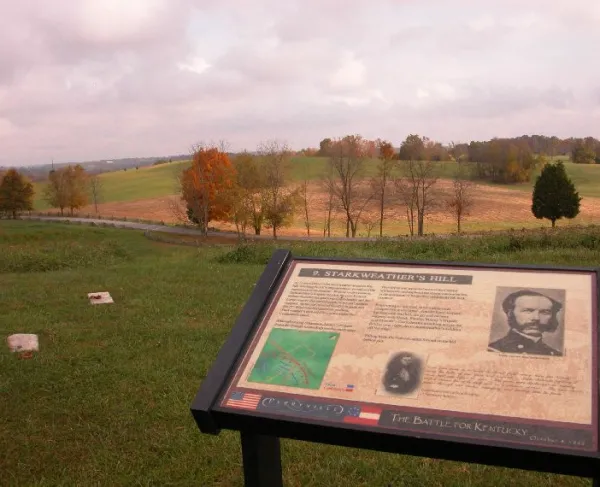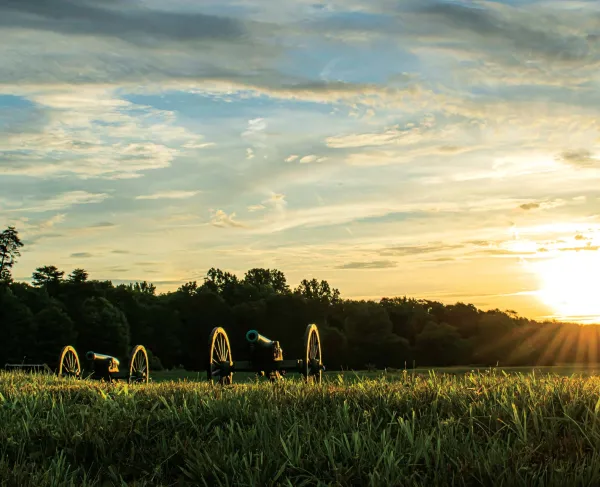(Washington, D.C.) – The Civil War Trust, America’s premier battlefield preservation organization, has announced the conclusion of another year of historic land conservation. Through the generosity of individual donors, coupled with strategic partnerships with government officials and nonprofit groups across the country, the Trust protected 2,373 acres of battlefield land in 11 states during 2016. The Trust had over 2,000 additional acres under contract at year end.
“I am confident that 2016 will be remembered as the year that some of America’s most critical unpreserved battlegrounds were finally saved,” said Trust President James Lighthizer. “History was written on our nation’s battlefield lands, and setting aside these hallowed grounds for the education and enjoyment of future generations will be a lasting legacy of the Trust.”
Working closely in cooperation with willing landowners and preservation partners, the Trust completed 44 transactions at 32 battlefield sites: Rocky Face Ridge, Ga.; Mill Springs and Perryville, Ky.; Antietam, South Mountain and Williamsport, Md.; Corinth and Port Gibson, Miss.; Bentonville and Averasboro, N.C.; Honey Springs, Okla.; Brandywine and Gettysburg, Pa.; Charleston, Hanging Rock and Waxhaws, S.C.; Fort Donelson, Franklin and Stones River, Tenn.; Appomattox Courthouse, Brandy Station, Cedar Mountain, Chancellorsville, Cold Harbor, Fredericksburg, Gaines’ Mill, Kernstown, Reams Station, Second Manassas, Trevilian Station and Williamsburg, Va.; and Shepherdstown, W.V.
The Trust celebrated several landmark successes in 2016, including the conclusion of a $5.5 million national campaign to preserve, restore and interpret the four-acre headquarters site of Gen. Robert E. Lee during the Battle of Gettysburg. In Kentucky, the protection of 70 acres at Perryville nearly completes preservation work at that battlefield. And the purchase of 355 acres at the Chancellorsville and Wilderness battlefields in Virginia physically connects the stories of these 1863 and 1864 battles for the first time.
In December, federal legislation passed to expand the boundary of Petersburg National Battlefield by more than 7,000 acres. The Trust has saved more than 2,000 acres associated with the Siege of Petersburg – at places like Five Forks, White Oak Road and the Petersburg Breakthrough – which eventually will be transferred to the National Park Service.
“We are grateful to the lawmakers and partner organizations who recognized the critical importance of preserving this historic Virginia landscape,” said Lighthizer. “These battlefields are living monuments – not just to the 70,000 men in blue and gray whose blood hallowed this ground – but to all of America’s veterans.”
The Trust’s Campaign 1776 project, the first-ever national initiative to preserve and interpret the battlefields of the Revolutionary War and the War of 1812, had a successful year as well. In July, the Trust launched a campaign to save 1,037 acres at six sites of the Southern Campaign of the American Revolution, where many historians believe the war was won. And in December – after a two-year advocacy campaign – the Trust reached an agreement with the Institute for Advanced Study to preserve 15 acres of historic land at the Princeton battlefield. This land was the scene of George Washington’s famous counterattack during the January 3, 1777 Battle of Princeton.
“The preservation of the Princeton Battlefield is an achievement of national importance,” said Jack Warren, executive director of the American Revolution Institute of the Society of the Cincinnati. “Washington’s remarkable victory at Princeton stunned the British and opened the road that led to American independence. The Princeton battlefield is a monument to courage, resourcefulness and stubborn determination – characteristics at the heart of our national identity.”
In addition to its land acquisition successes, the Trust promoted greater appreciation and understanding of America’s defining conflicts through its innovative educational programs and digital offerings. In 2016, the Trust website received more than 25 million page views, and Campaign 1776 added numerous Revolutionary War battle summaries, videos and animated maps to its collection of online resources. The new In Your State video series allowed viewers to learn more about each state’s involvement in the Civil War through historical narratives and engaging multimedia. And the Trust’s In4 series of short educational videos added more than two dozen new topics in 2016, including the launch of videos focusing on the American Revolution and War of 1812.
Three thousand students and teachers benefited from the Trust’s Field Trip Fund, which raised more than $30,000 in 2016 to assist teachers in planning and paying for student trips to historic sites. Four thousand students dove into a Traveling Trunk containing Civil War artifacts, books and music. The Generations program, a project to help young people engage with history, brought families to attack and defend Little Round Top at Gettysburg, walk in the footsteps of a Wilderness soldier in Virginia, and discover life on the home front at Antietam.
The Trust also earned accolades for its sound fiscal management and commitment to top-notch donor relations. The Trust received another exceptional 4-star rating from Charity Navigator, America’s leading charity evaluator, for a seventh straight year — an honor attained by only 2 percent of charities assessed by that organization. A GuideStar Gold Exchange member through Guidestar.org, the Trust also renewed its Better Business Bureau Wise Giving Alliance accreditation and received a prestigious Top-Rated Award by GreatNonprofits, the leading provider of user reviews about nonprofit organizations.
The Trust’s preservation success in 2016 would not have been possible without the dedication of Trust partners, including: American Battlefield Protection Program, National Park Service, Bentonville Battlefield State Historic Site (N.C.); Birmingham Township, Pa.; Boyle County Fiscal Court (Ky.); Chester County, Pa.; City of Franklin, Tenn.; Georgia Department of Natural Resources; Jefferson County Historic Landmarks Commission (W.V.); Kentucky Heritage Council; Lancaster County, S.C.; Madison County Fiscal Court (Ky.); Maryland Department of Natural Resources; Maryland Department of Transportation; Maryland Heritage Areas Authority; Maryland Historical Trust; Mississippi Department of Archives and History; North Carolina Department of Natural and Cultural Resources; Oklahoma Historical Society; Pennsylvania Historical and Museum Commission; Pulaski County Fiscal Court (Ky.); South Carolina Conservation Bank; Tennessee Civil War Sesquicentennial Commission; Tennessee Historical Commission; Virginia Department of Conservation and Recreation; Virginia Department of Historic Resources; Washington County, Md.; and Whitfield County, Ga.
Numerous organizations also contributed to these preservation successes, including: Averasboro Battlefield Commission; Battle of Franklin Trust; Brandy Station Foundation; Brandywine Conservancy; Central Maryland Heritage League; Central Virginia Battlefields Trust; Dalton Utilities; Franklin’s Charge; Friends of Perryville Battlefield; Friends of Shiloh National Military Park; Friends of Stafford Civil War Sites; Friends of Vicksburg National Military Park and Campaign; Friends of Wilderness Battlefield; Georgia Piedmont Land Trust; Gettysburg Foundation; HTR Foundation; Katawba Valley Land Trust; Kernstown Battlefield Association; Land Conservancy of Adams County; Land Trust of the Eastern Panhandle; Land Trust of Virginia; Lyndhurst Foundation; Manassas Battlefield Trust; Mill Springs Battlefield Association; National Parks Conservation Association; Petersburg Battlefields Foundation; Piedmont Environmental Council; Princeton Battlefield Society; Richmond Battlefields Association; Riverview Foundation; Save Historic Antietam Foundation; Shenandoah Valley Battlefields Foundation; Shepherdstown Battlefield Preservation Association; Silver Companies; South Carolina Battleground Preservation Trust; Tennessee Civil War Preservation Association; The Journey Through Hallowed Ground Partnership; Trevilian Station Battlefield Foundation; and Williamsburg Battlefield Association.
The Civil War Trust is the largest and most effective nonprofit organization devoted to the preservation of America’s hallowed battlegrounds. Although primarily focused on the protection of Civil War battlefields, through its Campaign 1776 initiative the Trust also seeks to save the battlefields connected to the Revolutionary War and War of 1812. To date, the Trust has preserved close to 45,000 acres of battlefield land in 23 states.
###
The Civil War Preservation Trust became the Civil War Trust in January 2011; the Civil War Trust became a division of the American Battlefield Trust in May 2018. Campaign 1776 was created in 2014 as an initiative of the Civil War Trust; in May 2018 it became the Revolutionary War Trust, a division of the American Battlefield Trust.


